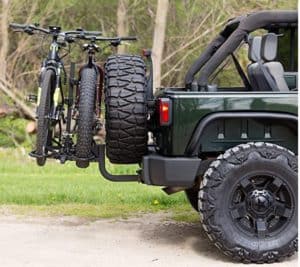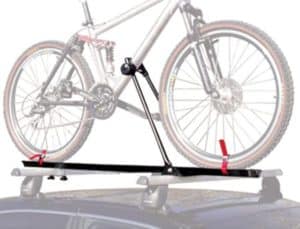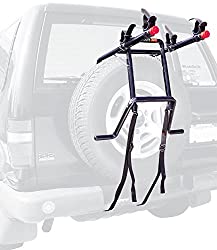A bike rack offers you the safest and most convenient way to transport your bike in a car. You, however, have to care for your two-wheel on transit. So, how do you protect a bike on a bike rack?
First, start by mounting the bike rack correctly. Then stabilize the wheels on the bike frame before covering the bike. And to boost the bike’s safety, lock it and cushion it with bubble wrap.
We’ll discuss all these bike protection steps in detail. We’ll look at the specific things to do and what to get to ensure you safeguard your bike while on a road trip.

My goal is to enable you to transport your bike in the safest way possible. So, not only will the ideas protect your bike on transit but your car too.
Let’s get started:
How Do You Protect A Bike On A Bike Rack? (5 Steps)
Here are the critical steps for protecting a bike on a bike rack:
Step 1 – Mount Your Bike Rack Correctly
If your bike rack is not well mounted on the car, it’s likely to move about as you drive or even detach from the vehicle.
If it moves about aimlessly, your bike will also move and rub against the car’s painting. And if it detaches, your bike will fall with and could break, especially the seat post and handlebar.
So, why don’t you avoid the risk by ensuring you mount the rack correctly before hitting the road?
I cannot stress enough the importance of double-checking the installation instruction before putting a bike on a rack.
Also, test the rack’s strength before hitting the road. If it’s strong enough, you can go ahead and mount your bike.
Step 2 – Stabilize the Wheel on the Rack
The wheels are likely to move when you hit a bump or go through a rough road. For that reason, you have to fasten them to the bike frame.
That’s possible with a wheel stabilizer like the Epessa Bike Rack Wheel Stabilizer (View on Amazon).

Such a wheel stabilizer straps your wheels firmly to the frame to prevent them from moving about and rubbing against the car’s body.
Step 3 – Cover Your Bike
Bad weather, especially the snow and rain, is a threat to the bike frame, drivetrain, chain, handlebar, and other metallic parts.
That’s because the wetness encourages rusting, which weakens and eats away the metallic parts.
The other threat is dust, which scratches the bike components. We cannot forget to mention the sun, which can fade your frame and weaken the tires and plastic parts.
The good news is that such threats are preventable with a bike cover for bike rack. One of the best bicycle covers on the market is the Team Obsidian Waterproof Bicycle Cover (View on Amazon).

This cover comes in a UV-protected, waterproof, rip-stop, and dustproof fabric to protect your bike against bad weather, dust, and dirt.
The bike cover allows you to lock your bike on the frame, thus compatible with bike locks, and you can quickly load it with the bike on the rack.
Step 4 – Lock the Bike on the Rack
Assuming that you have to leave your bike on the rack at night, you have to secure it. You can do that by locking it on the bike rack.
Luckily, most bicycle covers for traveling allow you to lock the bike while they (the bike covers) are on.
Preferably, use a bike lock with a cable like the Via Velo Bike U-Lock (View on Amazon). This bike lock is easy to use on your bike and even comes with mounting brackets for easy and secure locking.

Moreover, it comes with a PVC cover to protect it from dust, dirt, and moisture.
Generally, here’s how to lock a bike on a bike rack:
- Install the mounting brackets on the bike frame
- Place the bike on the rack and then tie the lock cable around it
- Lock the u-lock and keep the keys safe
Step 5 – Cushion the Bike with Bubble Wraps
The bike shouldn’t be touching the car while on transit. While most bike racks ensure that it’s always the case, there is always the chance that the wheels, handlebar, and pedals may move if you don’t fasten them to the frame.
If that happens, the bike could scratch your car.
Luckily, all these issues are fixable with bubble wraps. The bubble wraps offer an adequate cushion to your bike when you go through the bumps and gravel roads.

Other Smart Tips On How To Protect A Bike On A Bike Rack
Here are some extra tips worth considering:
a) Position Your Bike Correctly on the Rack
Sometimes, all it takes to transport a bicycle on a bike rack securely is to position the bike correctly. You can only transport your bicycle safely if it’s stable on the rack.
You have to ensure that you position its centrally regardless of the rack’s mounting location. It’s best if you do that before strapping or locking the bike on the bike rack.
b) Use a Roof Rack Instead

While mounting the bike on the roof is a lot of work, it eliminates the risk of the bicycle rubbing against the bike’s side or hitting the glasses.
So, as long as you don’t plan to ride fast, a roof rack is a convenient way to transport your bike safely. Besides, this approach doesn’t block the vehicle’s rear access.
What’s more, an excellent rear rack holds both wheels, eliminating the need for a rack wheel stabilizer.
One such rack is the Swagman Upright Roof Mount Bike Rack.
This roof rack can hold a 35-pound bike and is generally easy to install and use.
Since you have to get the bike to the roof, a roof rack is best for long-distance trips.
c) Put Your Bike In Whenever Possible
If you don’t have a bike lock for securing your bike on the rack, dismount the bike from the rack and put it inside the car. You can also get it into your motel room.
Doing so reduces the likelihood of someone stealing the bike or tampering with it. It is also recommendable if you transport your bike on the rack with a bike cover and it starts to rain.
Your bike is generally safer indoors than outside when you make a lengthy stop at midnight.
d) A High-Quality Bike Rack is King

While all the above tips are essential, it goes without saying that you need a quality bike rack.
The worst thing you can do is invest in a low-quality bike rack, as it could easily fall apart. And if it does, your bike will fall in the middle of the road.
It’s also essential that the bike rack support the bike’s weight.
Note that some bike racks can hold multiple bikes while others only carry one cycle.
Remember, a quality bike rack doesn’t just hold your bike securely, but it also promises lasting use.
e) Clean the Bike at Destination
This step is crucial for those who don’t use bicycle covers for bike racks.

Generally, dust and dirt could run your chain and drivetrain. And to avoid it, you should clean and lubricate your chain and drivetrain when you get to your destination.
It’s usually more straightforward when you have a quality degreaser, and a good recommendation is the WD-40 Specialist Bike Degreaser.
The degreaser has fast-action properties against hardened grease, dust, dirt, and grime. Plus, it doesn’t contain any harsh chemical which could potentially damage your bike’s paint, thus safe.
Moreover, this degreaser has lubrication properties, which means it also greases your chain and drivetrain.
f) Prepare for Bad Weather
Apart from road vibrations, the other weighty threat to your bike while traveling is terrible weather.
You’ve seen the importance of bike covers against bad weather, which means they are worth getting. But if you don’t have one on you, find a waterproof tarp and park it for the trip.
You can even use it to cover all your other gears alongside the bike rack if you use a roof rack. You’ve to learn how to secure your bike on a bike rack at all times!
g) Get Insurance Coverage for Your Bike If Necessary
Some auto insurance companies don’t consider a bike mounted to the hitch rack to be part of the car. So, they expect you to take additional coverage for the bike when going on a long bike trip.
For that reason, ensure you get some clarification from your auto insurance company before hitting the road if you are using a hitch rack.
Also Read:
So, How Do You Protect A Bike On A Bike Rack? Closing Thought:
Generally, you’ve to secure your bike on the rack by ensuring the bike rack is firm, the wheels don’t move about, and by covering the cycle.
Above is a detailed guide that you can use to safely and conveniently transport your bike on a bike rack.
Frequently Asked Questions
How can I prevent my bike from being stolen off of my car rack?
There’s nothing more disheartening than finding your beloved bicycle missing, and the bitter fact is that no lock or security measure is 100% foolproof. However, there are steps you can take to significantly decrease the odds of theft. A primary one involves utilizing your car rack’s inbuilt security measures. If your roof rack is equipped with integrated locks, make sure these are always engaged. Similarly, if your rack fastens to the bars of your vehicle, those locks should be used as well.
There's a second precaution you can take when you need to step away from your vehicle – employ a bike lock. Loop it around the bicycle frame and the rack, ensuring it complies with any insurance stipulations. When I was touring across North America, this double-lock technique saved my bike from being stolen in a motel car park. However, in this situation, do ensure any locks do not interfere with your vehicle's operations or cause any potential harm to other road users.
Perhaps the best advice I can provide is this: Always remain vigilant and cautious, especially in areas where bike thefts are common. Never assume your bike is 'safe enough' and completely theft-proof. Spend time investing in high-quality locks and consider additional anti-theft devices like alarms or GPS trackers.
Is it necessary to lock my bike even if it’s on a bike rack?
Many cyclists I’ve met on my biking adventures assume their bikes are safe without a lock when they’re on a rack. Unfortunately, this isn’t always the case. In my experience, a hearty U-lock and a well-anchored bike rack will dissuade most opportunistic thieves you’re apt to encounter. This safety measure is all the more critical if your bike has quick-release wheels. These present an easy opportunity for thieves to quickly disassemble your bike and remove it from the rack.
In this case, I'd recommend using an additional security measure such as a secondary U-lock, a quality cable lock, or even locking skewers. Another experienced cyclist friend of mine strongly suggested using a retention system, which essentially means improving the fastenings on your bike so that the components do not unintentionally loosen or fall off.
However, always keep in mind that it's better to err on the side of caution, considering how precious your bikes probably are to you. The better secured your bike, the less attractive it is to would-be thieves.
How can I ensure my carbon bike is safe on my car rack?
As a passionate cyclist and a proud owner of a carbon bike, I appreciate the concern for maintaining a carbon bike’s integrity during transportation. Carbon bikes are indeed more vulnerable to damage, mainly when attached to a car rack.
Before the journey, securely fasten your bike to your rack. Be careful not to overdo the tightening on the clamps of your mount points since too much pressure can deform or crack the carbon frame. I usually employ foam pieces on these points to doubly ensure the frame doesn't suffer any scratches or damages during transportation.
While it's crucial that the frame has no slack to prevent your bike from moving around when the vehicle is in motion, you should also make sure it doesn't come into contact with the rack, the vehicle itself, or other bikes or luggage you have mounted.
Remember, when it comes to transporting a carbon bike: It's all about getting that balance of securing it well without causing any pressure points that can damage the carbon frame. Precautionary measures can help protect your valuable ride.
Where should I lock my bike on a bike rack?
Understanding where to lock your bike on a bike rack is paramount for optimal security. Based on what I’ve learned through years of biking and discussions with fellow cyclists, the most foolproof method comprises two locks.
Preferably, you're locking your bike to a bike rack that's solidly grounded and extremely difficult to tamper with. The first lock should securely encase the rear wheel, the frame, and the bike rack. For the second lock, position it to secure the front wheel, the frame, and ideally, the bike rack too. This "double-lock" method has thus far been a successful strategy for many of my biking colleagues.
The take-away from this is: The optimal way to lock your bike involves both wheels and the frame. This method greatly deters potential thieves by making theft a time-consuming task. Always remember: the more time and effort needed to steal a bike, the less attractive it becomes.